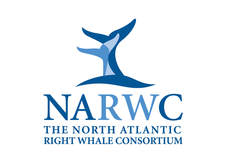general
Scientists named the North Atlantic right whale Eubalaena glacialis, which means "good", or "true" whale of the ice in Latin, the language used by all scientists to name and classify animals and plants. There are two other species of right whale, Eubalaena australis, which lives in the southern hemisphere, and Eubalaena japonica, the North Pacific right whale. The three different species of right whales never meet in their ocean travels.
Although previous estimates suggested that growth of the North Atlantic population was about 2.5% annually, this is far below the growth that their Southern right whale counterparts exhibit (7%) and recent analyses suggest that the population is now exhibiting signs of declining. Studies suggest that human sources of mortality, including vessel strikes and entanglement in fishing gear, are significantly impacting the reproductive success of right whales and may have a greater impact on the growth rates of the North Atlantic population than other large whale species. Scientists and government officials in both the United States and Canada are working with the shipping and fishing industries to find ways for right whales and humans to coexist safely in the ocean.
There are very likely also natural forces working against the survival of the right whale. For instance, no one knows if right whales are getting enough food and although we humans are helpless to improve their food supply, changes in how we treat the oceans would result in a healthier ecosystem that could provide enough food for even its largest members. But, until we totally understand what is happening to the right whale, we must concentrate on protecting them and their habitat areas from harm wherever possible.
Although previous estimates suggested that growth of the North Atlantic population was about 2.5% annually, this is far below the growth that their Southern right whale counterparts exhibit (7%) and recent analyses suggest that the population is now exhibiting signs of declining. Studies suggest that human sources of mortality, including vessel strikes and entanglement in fishing gear, are significantly impacting the reproductive success of right whales and may have a greater impact on the growth rates of the North Atlantic population than other large whale species. Scientists and government officials in both the United States and Canada are working with the shipping and fishing industries to find ways for right whales and humans to coexist safely in the ocean.
There are very likely also natural forces working against the survival of the right whale. For instance, no one knows if right whales are getting enough food and although we humans are helpless to improve their food supply, changes in how we treat the oceans would result in a healthier ecosystem that could provide enough food for even its largest members. But, until we totally understand what is happening to the right whale, we must concentrate on protecting them and their habitat areas from harm wherever possible.
